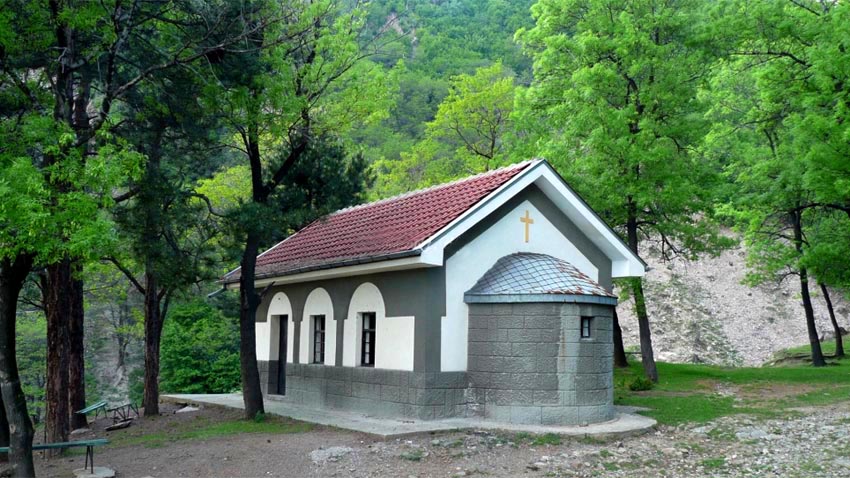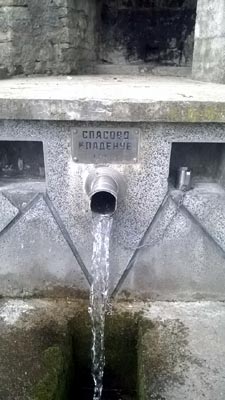In 2018 the Feast of the Ascension of Christ (Spasovden) falls on May 17. Many people will gather again on the large meadow near the Spassov Well. The place is emblematic for the town of Zlatitsa (Central Bulgaria) and the whole region. Since time immemorial people have been going there to pray for sound health and honor the healing power of nature. The fountain itself is situated on Spasova Mogila (Spasov Mound) at the foot of the Balkan Mountain Range. The access to the spring is easy. A designated asphalt pathway takes locals and tourists straight to the spring. A small stone chapel was built on this place to honor Saint Spass. The local people have been maintaining the chapel over the years with own financing. Hundreds of people will gather on the Ascension of Christ feast on this place to fill their bottles with healing water, light a candle and pray for good health, just like their ancestors. Few people, however, know that this place was a sanctuary many centuries before Christ.

The clear water of the well springs deep from the earth. It is as pure as a tear drop and its temperature does not change over the seasons. Different people have come here for centuries and left a coin on this place. They were perhaps led by the same faith which makes people nowadays toss coins in wells, water fountains and springs, hoping to make their dreams come true. The small coins are still there to tell stories about previous generations. Several years ago we found nearly 80 coins during excavation works near the fountain. The oldest coin dates back to the Thracian period, Boris Gechev from the town of Zlatitsa told Radio Bulgaria. He founded a small museum to preserve and show the finds to the future generations. More from Boris Gechev himself:
 “Perhaps you would ask where the name of Spassov Well comes from. Our ancestors managed to withstand the pressure of the Ottoman invaders for over 30 years. Thus, Zlatisa was among the last Bulgarian towns that fell under the Ottoman Rule. There are many forts in this region, but when the Big Citadel, situated in Zhekov Vir area, fell under Ottoman Rule, all women, children and men hid in a small fortress above the town of Zlatitsa near Golesh peak. There were two great voivodes in Zlatisa at that time- Spas and Salko. Salko voivode took the local people to the fortress above the town and Spas voivode managed to beat off the Ottoman posse with two detachments. The battle between the Bulgarians and the Ottomans was held in Brusovete area opposite the Spasov Well. Spas voivode was severely wounded in the battle. His fellows took him to the well and washed his wounds. Soon, his wounds healed and the revolutionaries named the well after Spas voivode in celebration of the feat and the heroism of their leader. I asked engineers and chemist from a university in Starta Zagora, who worked at the local copper plant, to make a detailed microbiological analysis of the water. The results of the analysis showed that it belongs to the group of the mineral waters. No microorganisms were found in the water and it is similar to the distilled water. That is why the water from this well protected the wounds of Spas voivode from infection.”
“Perhaps you would ask where the name of Spassov Well comes from. Our ancestors managed to withstand the pressure of the Ottoman invaders for over 30 years. Thus, Zlatisa was among the last Bulgarian towns that fell under the Ottoman Rule. There are many forts in this region, but when the Big Citadel, situated in Zhekov Vir area, fell under Ottoman Rule, all women, children and men hid in a small fortress above the town of Zlatitsa near Golesh peak. There were two great voivodes in Zlatisa at that time- Spas and Salko. Salko voivode took the local people to the fortress above the town and Spas voivode managed to beat off the Ottoman posse with two detachments. The battle between the Bulgarians and the Ottomans was held in Brusovete area opposite the Spasov Well. Spas voivode was severely wounded in the battle. His fellows took him to the well and washed his wounds. Soon, his wounds healed and the revolutionaries named the well after Spas voivode in celebration of the feat and the heroism of their leader. I asked engineers and chemist from a university in Starta Zagora, who worked at the local copper plant, to make a detailed microbiological analysis of the water. The results of the analysis showed that it belongs to the group of the mineral waters. No microorganisms were found in the water and it is similar to the distilled water. That is why the water from this well protected the wounds of Spas voivode from infection.”
The oldest manuscripts (of brothers Georgi and Pancho Duraliev) that mentioned the location of the well date back to the 15th century. Georgi and Pancho had a family notepad which has retained the generic memory for over five centuries. More about the history of the Spasov Well:
“The oldest coin found on the bottom of the well is a silver Thracian coin. The obverse side of the coin depicts God Dionysus (Ancient Greek God of wine, vegetation and festivity). The reverse side depicts Heracles holding a mace in his left hand and a lion’s fur skin in his right hand. Heracles was a divine hero in Greek mythology, a paragon of masculinity, known for his twelve labors including the battle with the lion. We also found a coin dating back to the 1st century BC. It was minted on Thassos Island. A silver Roman Denarius dating back approximately to the same period was also found there. We found several Roman and Byzantine coins as well. A hollow coin dating back to the Second Bulgarian Kingdom was also found in Spasov well. It was minted during the rule of King Ivan Asen II. Coins from the First Bulgarian Kingdom, which are now possessed by the National Museum of History, were also found in this area. An ancient pearl cross depicting Christ and other adornments were also found here. We also found some Celtic artefacts on this place. Now people continue to toss coins into the Spassov Well. Some of them will stay here for centuries and will be discovered by the future generations. Everything we found on this place shows that it has been a sanctuary since time immemorial.”
English version: Kostadin Atanasov
Photos: private library and sabori.bgOn November 24, the Bulgarian Orthodox Church honors St. Catherine (Sveta Ekaterina in Bulgarian) , who was one of the most educated women of her time. She lived in the late 3rd and early 4th centuries and came from a noble family in Alexandria...
The Patriarchal Cathedral of St Alexander Nevsky is celebrating its temple feast today. The cathedral, a symbol of the Bulgarian capital, was built "in gratitude to the Russian people for the liberation of Bulgaria from Ottoman rule in 1878". Who..
On November 22 and 23, the Bulgarian Orthodox Church will solemnly celebrate the 100th anniversary of the consecration of the Patriarchal Cathedral "St. Alexander Nevsky" . For a century the cathedral has been "a witness to all the hopes and..
At sunset on December 25, the Jewish community begins to celebrate Hanukkah. The holiday begins on the 25th day of the Jewish month of Kislev in the..
The Bulgarian Orthodox Church celebrates Christmas with solemn services. The festive services began on Christmas Eve, when the church held a solemn..
On the third day of Christmas, December 27, the Bulgarian Orthodox Church commemorates the memory of Saint Stephen, the first Christian martyr. His name..

+359 2 9336 661
